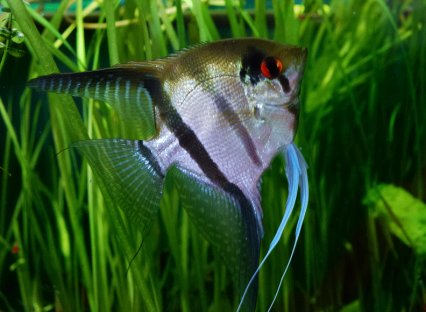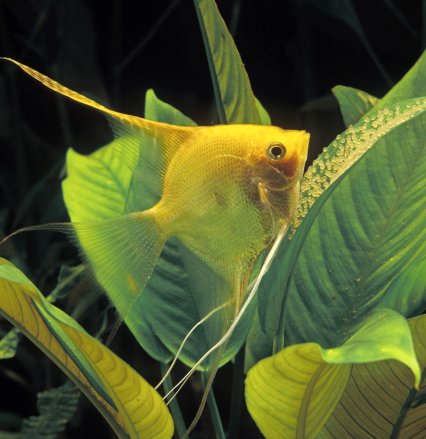
Copyright © Thinkstock
It is always fascinating to compare how fishkeeping practices have changed over the years. John Rundle travels over 80 years back in time to look at how early angels fared.
I was recently flipping through a 1929 issue of Aquarist and Pondkeeper and chanced upon an article on angelfish. Gracing the pages was a splendid black-and-white photograph of a superb Silver angelfish, Pterophyllum scalare.
Reading the opening lines rang true even today: "From the aquarists' point of view, the angelfish is in a class by its self (sic). There is no other freshwater fish yet imported which can show so weird yet beautiful a shape."
As an exercise, I have reproduced excerpts from that article by W. S. Pitt and answered the pertinent points with my own thoughts.
Pitt: Many people in this country have got their first impression of Angel Fish from those exhibited in public aquaria. Many aquarists do not attempt to keep scalare, being under the impression that they are delicate and very expensive to purchase. Anyone, however, who is in the position to maintain a temperature of 70°F and over, and if he can purchase young fish, he can get these... for a few shillings.
Rundle: Remember this was 1929, not long after it was first introduced to the hobby. The species scalaris was scientifically named in 1823 and placed in the genus Zeus. In 1840, Heckel gave it its own genus Pterophyllum. Then in 1909, a few fish were collected in the Amazon by German Bruno Sagratzki and brought back to Germany. So when Pitt wrote the article, it was still fairly new to fishkeepers in this country.
Today, P. scalare is considered quite hardy. It's possible that the fish Pitt was talking about was not far from the wild stock, and it also looks like the specimens were kept in cooler temperatures than what angelfish prefer. For instance, I keep them in at least 27°C/80°F.
As for price, adverts in that issue show that small angels were being sold for 3/6p (3 shillings and sixpence). This is roughly about £12 and that would be a month's income back then. A huge difference to today.
Pitt: It is not essential to have a separate tank, as unlike most cichlids to which family Angel Fish belong, they are quite peaceable with other fish, nor do they disturb the weeds. Full grown fish are about 5in long and 8in from the tip of the dorsal to the end of the anal fin, so that a large and deep tank is desirable; particularly as the fish like to keep about mid-way in the water and hate to have their "feelers" trailing on the sand floor.
Rundle: I once kept six mature angels with a group of Corydoras sterbai. So I have to agree with Pitt that they will live with other fish, but there can be some tension if a pair decide to spawn.
My angelfish were large and not far from the size he quotes "a tank 38cm/15in deep is ideal for them. However, I'm not so sure about his point on their hating their feelers trailing on the "sand".
Pitt: Most scalare will eat only living food such as Daphnia, bloodworm, small water-boatman, water-beetle larvae and young fish.
Rundle: Yes, scalare do love live foods, but I am not so sure about water boatman, water beetle larvae and especially young fish. We can, of course, use live Daphnia, bloodworm and whiteworm, and they will eat most dry foods.
Pitt: I do not propose to describe the breeding habits of scalare as I have never been able to induce those I had at one time or another even to spawn. It is, I think, generally agreed that to have any chance of success a large tank, adult fish and a temperature of 80°F and over are essential; also (a job as hard as any) a true pair. There are no generally accepted sexual characteristics.
Rundle: It is fascinating how these fish were considered not easy to breed. Again, I suspect this might be down to the fact that they must have been wild stock. However, Pitt was correct his assumptions, namely that one needed adult fish (not necessarily full grown); high temperatures; and true pairs and he was correct that they can be difficult to sex.

Possibly the first account of a breeding was written by Rev. Bartram Stower in the winter 1929 edition. I've reproduced excerpts, keeping his words – remember, this was 1929! The author had kept his 12 angelfish for two years before the successful spawning.
Stower: The 12 fish that were the size of a shilling (the size of 10p) were held in a glass tank but did not appear to grow, so two of them were passed on to Mr. S. G. Brown of Shepperton, Middlesex. He placed them into a water-lily pond that was situated in a tropical conservatory.
This pond is some fifteen feet in diameter, three feet deep and heated by submerged pipes. At the time Platypoecilus maculatus (we now know it as Xiphophorus maculatus - Rundle) was also in the pond. The experiment proved highly successful, and within a fortnight the two had doubled.
As a result the remaining ten were placed in the pond, where they throve in a surprising manner and in perfect harmony with its other denizens. The pond abounds with a glutinous dark green algae which grows thickly on its sloping sides. It is also full of large tropical water lilies, and Water hyacinths.
The only artificial food provided is a daily handful of Spratt's fine fish rearing meat meal mixed with an equal quantity of their fine biscuit meal.
The temperature is maintained at between 70-80°F and about 20 gallons of water is run in daily.
On August 3rd last, the presence of a pair of scalare among the roots of a pink water lily, and their unwonted boldness in refusing to be frightened away even when an attempt was made to touch them, a brood of young fry clinging to the stem of one of the pink lily-leaves, like transparent flies and closely guarded by the parent fish.
A smaller brood was also discovered on another leaf and removed to a small aquarium, as according to writers on the habits of scalare the parent fishes usually devour their young after a few days' solicitous attention.
The fry all died in the aquarium within a week.
August 4th. The brood in the pond was discovered to have migrated to a white water lily some six feet distant from their original home. Both parents were alert and guarding the young fish. Although a fair number of the youngsters clung to the stem of a lily leaf, others were actively swimming around, evidently seeking infusoria, and it was observed that those straying beyond the guarded areas were quietly collected by the parent fish in their mouths and gently ejected on to the lily stem.
This charming evidence of parental care was only observed this one occasion.
August 5th. A second brood was discovered which had evidently hatched at the same time.
August 26th. Their overall measurement is fully 1/2in from head to tail, there were about 200 fish. It is naturally disappointing that the spawn was not detected before they hatched; but it may here be said that, had the parent fish fanned and circulated the water around the spawn as it is said they do, this action would have at once attracted the attention of the writer.
It may thus be suggested that this so called "fanning" of the water around the spawn, presumably by the antennae, is no more than the threatening and pugilistic attitude previously mentioned and adopted by the parent fish in protecting their spawn and young.
At any rate, this peculiar and distinctly foreboding "sparring" with their "antennae" is still adopted by the angelfish here described, and have so far lived up to their name and altogether behaved in an exemplary and angelic manner.
Rundle: A note at the end of the article states that E G Boulenger, director of the Aquarium of the Zoological Society of London, visited the breeding site and confirmed that this was the first recorded breeding of P. scalare in the country.
It was interesting how the angelfish did not appear to do well in a tank, which was why they were moved to the pond. Possibly advances in heating and filtration countered those early problems.
We have a much wider array of foods to offer our fish today. Just think of the range of high-quality dry foods. This probably explains the slow growth in the tank then. The fry in the pond relied on natural infusoria and Spratt's fine fish rearing meal. Today, our angelfish fry get live brineshrimp nauplii.
It was also interesting how back then it was doubted that the parents fanned the eggs, and instead the behaviour was interpreted as threatening. Needless to say, things have changed dramatically over the years, but what an interesting slice of history!
Published: John Rundle Tuesday 22 February 2011
